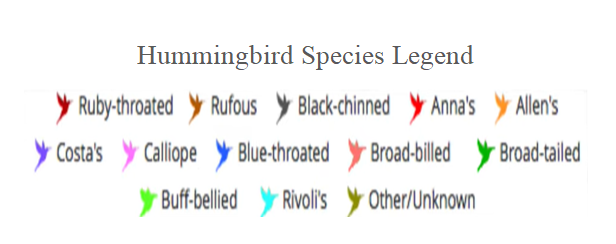Spring is just around the corner and that means it’s time for the annual hummingbird’s migration and return to the United States and lower Canada. Hummingbird migration is a fascinating natural phenomenon observed in most species of hummingbirds. While not all hummingbirds migrate, many species undertake remarkable journeys, covering thousands of miles between their breeding and wintering grounds. While hummer migrations occur elsewhere, the most well-known hummingbird migration occurs in North America.
Here are some key points about hummingbird migration:
- Species: The Ruby-throated Hummingbird (Archilochus colubris) is the only hummingbird species that breeds in eastern North America and migrates to Central America for the winter. Other species, such as Calliope, Rufous, and Black-chinned hummingbirds also exhibit migratory behavior.
- Migration Routes: Hummingbirds typically follow specific migration routes and can fly up to 23 hours in one day. Ruby-throated Hummingbirds, for example, fly across the Gulf of Mexico, covering approximately 500 miles in a non-stop flight that can take up to 18 hours.
- Timing: Migration timing varies depending on the species and location. In North America, Ruby-throated Hummingbirds usually start their migration in late summer or early fall, heading south for the winter.
- Trigger for Migration: The primary trigger for hummingbird migration is related to changes in daylight and hormonal shifts. As the days become shorter, hummingbirds receive signals to start their journey.
- Energy Reserves: Hummingbirds consume vast amounts of food to build up energy reserves before migration. They often double their body weight to prepare for the long flight.
- Wintering Grounds: Hummingbirds spend the winter in warmer climates with abundant food sources. In the case of the Ruby-throated Hummingbird, they may winter in Central America or even as far south as Panama.
- Return Migration: Hummingbirds also migrate back to their breeding grounds in the spring, usually following the same route. This return journey is prompted by environmental cues, including changes in temperature and daylight.
- Challenges: Migration poses numerous challenges for hummingbirds, including adverse weather conditions, the risk of predation, and the need to find suitable stopover locations for feeding and resting.
- Supporting hummingbirds: There are two primary ways we can help hummingbirds in their annual migrations. The first is to plant hummingbird friendly plants which offer nourishment and protection. Here are some suggestions:
Salvia
Columbine
Petunias
Bee Balm
Phlox
Honeysuckle
Delphinium
Daylilies
Lilies
Lantana
Trumpet Vine
Trees such as Redbud and Crabapple

The second way we can help hummers is to augment natural sources with hummingbird feeders. There are a number of feeders to choose from, but this is the feeder I found to be best:
Feel free to experiment. Hummers are naturally attracted to the color red, but I have found a clear feeder works equally well. Last summer I noticed equal numbers of hummers at both the clear and red tinted feeders.
If you choose to hang hummingbird feeders, the important points to remember are:
- Hang your feeder approximately 3-10 feet away from windows to prevent collisions and injuries. If possible, locate your feeder within 15-20 feet away from trees so hummers have a safe place to rest between feedings – which may be very 15 minutes during peak season. Finally, feeders should be located in a part-shade location. The heat from full sun positions, especially during summer, can spoil hummingbird solution quickly.
- Speaking of hummingbird solutions, you can easily make your own hummer food by boiling 1 cup of water, then adding ¼ cup sugar. Allow the solution to cool, then hang the feeder. Larger amounts can be pre-made, then safely refrigerated for up to a week. Pre-made solutions are usually fine but check their ingredients carefully. Do not use those which contain dyes or other additives. Also, NEVER USE HONEY as a feeder ingredient. Not only can honey cause a hummingbird to choke, but honey also causes fatal fungal and bacterial infections in hummers.
- Lastly, it is important to regularly inspect and clean your hummingbird feeder. Feeders should be taken down, dismantled, and washed with hot soapy water at least 1x/week to prevent dangerous mold and bacterial culturing. If your feeders are dishwasher safe, the dishwasher is a fast and effective way to keep your feeders clean and safe for their next use.
Citizen science projects, such as the Hummingbird Monitoring Network and Hummingbird Central, contribute significantly to our understanding of hummingbird migration patterns. Researchers and bird enthusiasts use banding and tracking techniques to monitor the movements of these tiny, agile birds so we can learn more about their incredible migratory journeys. If you are interested in hummingbird migration, I have included last year’s (2023) hummingbird migration map – fun and interesting to play with – and this year’s current interactive 2024 migration map from Hummingbird Central which is updated every day to reflect migration sightings across the United States and Canada. Hummingbird Central also offers a hummingbird sighting form on their sight which readers can fill-out and submit online as they see hummers in their area.
Enjoy!









